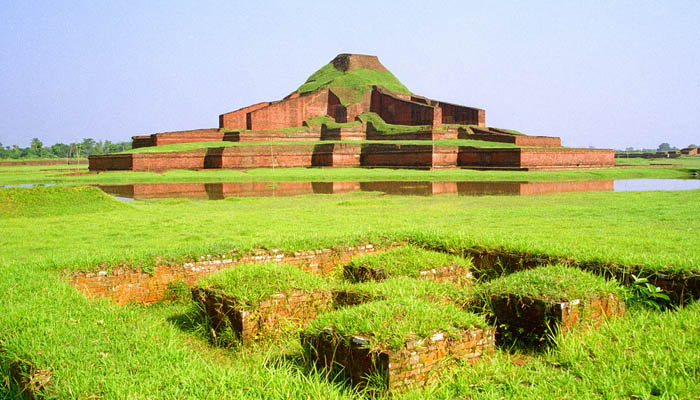- Details
- Hits: 16861
Paharpur Buddha Vihara
Paharpur, Badalgachhi Upazila, Naogaon District, Bangladesh (25°1'51.83"N, 88°58'37.15"E) is among the best known Buddhist viharas in the Indian Subcontinent and is one of the most important archeological sites in the country. It was designated a UNESCO World Heritage Site in 1985.A number of monasteries grew up during the Pāla period in ancient Bengal and Magadha. According to Tibetan sources, five great Mahaviharas stood out:Vikramashila, the premier university of the era; Nalanda, past its prime but still illustrious; Somapura Mahavihara;Odantapurā; and Jaggadala. The monasteries formed a network; "all of them were under state supervision" and there existed "a system of co-ordination among them ... it seems from the evidence that the different seats of Buddhist learning that functioned in eastern India under the Pāla were regarded together as forming a network, an interlinked group of institutions," and it was common for great scholars to move easily from position to position among them. The excavation at Paharpur, and the finding of seals bearing the inscriptionShri-Somapure-Shri-Dharmapaladeva-Mahavihariyarya-bhiksu-sangghasya, has identified the Somapura Mahavihara as built by the second Pala king Dharmapala (circa 781–821) of Pāla Dynasty. Tibetan sources, including Tibetan translations of Dharmakayavidhi and Madhyamaka Ratnapradipa,Taranatha's history and Pag-Sam-Jon-Zang, mention that Dharmapala's successor Devapala (circa 810–850) built it after his conquest of Varendra.The Paharpur pillar inscription bears the mention of 5th regnal year of Devapala's successor Mahendrapala (circa 850–854) along with the name of Bhiksu Ajayagarbha. Taranatha's Pag Sam Jon Zang records that the monastery was repaired during the reign of Mahipala (circa 995–1043 AD).The Nalanda inscription of Vipulashrimitra records that the monastery was destroyed by fire, which also killed Vipulashrimitra's ancestor Karunashrimitra, during a conquest by the Vanga army in the 11th century, assumed to be an army of the Varman rulers. About a century later Vipulashrimitra renovated the vihara and added a temple of Tara.During the rule of the Sena dynasty, known as Karnatadeshatagata Brahmaksatriya, in the second half of the 12th century the vihara started to decline for the last time. One scholar writes, "The ruins of the temple and monasteries at Pāhāpur do not bear any evident marks of large-scale destruction. The downfall of the establishment, by desertion or destruction, must have been sometime in the midst of the widespread unrest and displacement of population consequent on the Muslim invasion."
Central temple
The purpose of this central structure at the midst of the courtyard remains unsolved since its discovery. Hence, most of the debates generated hitherto on the architecture of Sompur Mahavihara are cantered on the identification its missing superstructure. The reason may be manifold, but the most important one is the non-availability of substantial amount of first-hand resource including a comprehensive architectural documentation at the disposal of the researchers. There are different arguments regarding the terminating top of the central structure of Sompur Mahavihara.Consequently, most of works done so far are mainly based on the findings of the archaeological excavation and studying the artefacts from the archaeological perspective. The first study on this monument with documentation was by archaeologist K.N. Dikhist in his Paharpur, Memoirs of Archaeological Survey in India (1938). Dikhsit was concerned with documentation of the archaeological findings and concentrated on their interpretation and analysis. He attempted to suggest a probable architectural treatment of the missing parts of the structure through studying the archaeological remains. Till today, this study is considered as the most authentic record of the Sompur Mahavihara.Prudence R. Myer published the first of such studies in 1969 as a journal paper, in which he proposed the missing superstructure as a stupa and illustrated the possible three-dimensional articulations. Myer embarked on his proposal through a diachronic study of the stupa and stupa shrines in India. He took Sompur Mahavihara as an example to elaborate his study and did a conjectural restoration of the central structure in support of his analysis.The second work was published around thirty years after Myer's proposition. A team of architects from Khulna University lead by Mohammed Ali Naqi has proposed another theoretical reconstruction of the central structure as well as some parts of the peripheral block (mainly the entrance hall) in 1999. This work was also presented in the "International Seminar on Elaboration of an Archaeological Research Strategy for Paharpur World Heritage Site and Its Environment" jointly organized by UNESCO and Department of Archaeology of Bangladesh in 2004. Muhammad Ali Naqi proposed a temple-like spire at the top by considering the central mound as a ‘Stupa-Shrine’ with a ‘Shikhara’ type stupa in his reconstruction.
Nameable statues found
The statues are reserved in the adjacent museum for display. Some nameable statues are:'Chamunda' Statue of Clay Stone, Standing 'Seetala' Statue of Red Stone, Broken Parts of 'Visnu' Statue of Krishna Stone, 'Keerti' Statue of Clay Stone, Damaged 'Haargouri' Statue, Broken Statue of Laxmi Narayan of Krishna Stone, 'Uma' Statue of krishna Stone, 'Gouri' Statue of Clay Stone, 'Visnu' Statue of Clay Stone, Nandi Statue, 'Visnu' Statue of Krishna Stone, Sun Statue, 'Mansha' Statue of Clay Stone.



